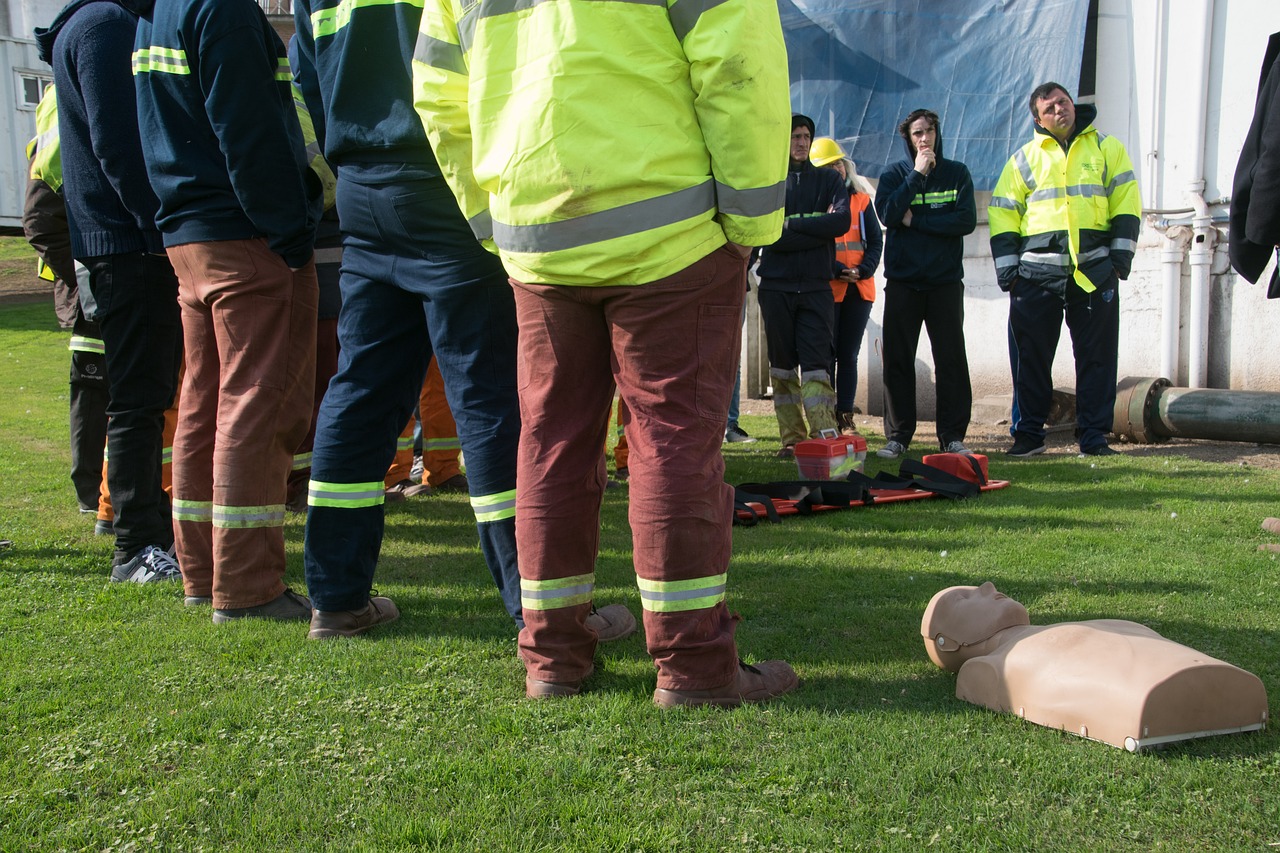Shaping Safety Measures using Human Behavior Understanding
In today's fast-paced world, safety is more than just a set of rules; it's a culture that needs to be cultivated. Understanding human behavior is the cornerstone of shaping effective safety measures that resonate with individuals and communities alike. Imagine safety protocols not as rigid guidelines but as flexible frameworks that adapt to how people think and act. By diving deep into the psychology behind behavior, we can tailor safety measures that not only protect but also engage and motivate people to make better choices. This article explores how insights into human behavior can enhance safety measures across various sectors, leading to improved outcomes and a more secure environment for individuals and communities.
Examining the psychological and social factors that influence human behavior is crucial for developing effective safety measures. Our motivations, perceptions, and decision-making processes are often shaped by a myriad of factors, from personal experiences to societal norms. For instance, why do some individuals ignore safety protocols while others adhere strictly to them? The answer lies in understanding the underlying psychological mechanisms. By tapping into these insights, organizations can craft safety protocols that resonate more deeply with individuals, leading to a greater likelihood of compliance and engagement.
Psychological principles play a significant role in shaping safety measures. By understanding cognitive biases—like the illusion of invulnerability or optimism bias—we can design interventions that truly resonate with individuals. For example, when people believe that accidents happen to others but not to themselves, they may neglect safety precautions. Addressing these cognitive distortions through targeted messaging can shift perceptions and promote safer behaviors. Emotional responses also matter; fear can either paralyze or motivate individuals. Crafting messages that evoke the right emotions can lead to a profound change in behavior and adherence to safety protocols.
Behavioral economics offers fascinating insights into how people make decisions regarding safety. It reveals that our choices are often influenced by irrational factors rather than pure logic. By leveraging these insights, organizations can create incentives that encourage safer choices among employees and the public. For instance, offering tangible rewards for adhering to safety protocols can transform compliance from a chore into a game. When people feel that their efforts are recognized and rewarded, they are more likely to engage in safe practices.
Creating reward systems can significantly motivate individuals to adhere to safety protocols. By understanding what drives behavior—be it recognition, financial incentives, or social approval—organizations can implement effective incentive programs. Consider a workplace where employees earn points for attending safety training sessions or reporting unsafe conditions. These points could be redeemed for prizes or recognition, fostering a culture of safety that feels rewarding instead of punitive. This approach not only enhances compliance but also builds a community focused on collective safety.
Identifying and addressing the factors that lead to risky behaviors is essential for enhancing safety in various environments. Tailored interventions can help mitigate these behaviors. For instance, if a particular demographic is prone to risky behaviors, targeted educational campaigns can address their specific concerns and motivations. This personalized approach can lead to more effective outcomes. By understanding the "why" behind risky behaviors, organizations can develop strategies that not only inform but also transform individuals' mindsets toward safety.
Social dynamics significantly impact safety practices. Peer pressure and group norms can either encourage or discourage safe behaviors. Understanding how these social influences operate can help organizations foster a culture of safety within teams and communities. For example, when safety becomes a shared value among team members, individuals are more likely to hold each other accountable. Encouraging open discussions about safety concerns and celebrating safe practices can strengthen these social bonds, ultimately leading to a safer environment for everyone.
Effective training and education are vital for instilling safe behaviors. Utilizing behavioral insights to design training programs can enhance engagement and retention, leading to better safety outcomes. Traditional training methods often fall flat because they fail to connect with participants on a personal level. By incorporating elements that resonate with human behavior—such as storytelling, real-life scenarios, and interactive components—organizations can create training experiences that stick.
Interactive learning methods, such as simulations and role-playing, can effectively teach safety protocols. These approaches engage participants and allow them to practice safe behaviors in a controlled environment. Imagine a fire safety training session where employees navigate a simulated emergency. This hands-on experience not only reinforces learning but also builds confidence in their ability to respond effectively in real situations. The more involved individuals are in their learning, the more likely they are to internalize and apply the safety measures they’ve learned.
Implementing continuous feedback mechanisms ensures that individuals receive ongoing support and guidance regarding safety practices. This fosters an environment of learning and improvement, ultimately enhancing overall safety. Regular check-ins, anonymous feedback channels, and open discussions about safety can create a culture where individuals feel valued and heard. This ongoing dialogue not only reinforces safe behaviors but also empowers individuals to take ownership of their safety and that of their peers.
- What is the importance of understanding human behavior in safety measures?
Understanding human behavior allows organizations to design safety protocols that resonate with individuals, making them more effective and engaging. - How can psychological principles enhance safety?
By recognizing cognitive biases and emotional responses, organizations can tailor interventions that promote safer behaviors. - What role does social influence play in safety practices?
Social dynamics can significantly impact safety behaviors, as peer pressure and group norms can either encourage or discourage safe practices. - How can training programs be made more effective?
Incorporating interactive learning methods and continuous feedback can enhance engagement and retention in safety training programs.

Understanding Human Behavior
When it comes to safety measures, understanding human behavior is not just a good idea—it's essential. Think about it: our actions are influenced by a myriad of psychological and social factors that dictate how we respond to risks and safety protocols. By examining these influences, we can develop safety measures that resonate with individuals on a deeper level. For instance, why do some people follow safety guidelines diligently while others seem to ignore them? This disparity often stems from differences in motivation, perception, and the decision-making process.
To truly grasp human behavior, we must delve into the cognitive processes that shape our actions. Cognitive psychology tells us that our brains are wired to make quick decisions, often relying on heuristics or mental shortcuts. These shortcuts can lead to cognitive biases, which skew our understanding of risks. For example, someone might underestimate the danger of texting while driving because they believe “it won’t happen to me.” Recognizing these biases allows us to create safety measures that counteract them, making compliance more intuitive.
Moreover, social influences play a significant role in shaping behavior. Humans are inherently social beings, and our actions are often guided by the norms and expectations of our peers. When we see others prioritizing safety, we are more likely to follow suit. This is where the concept of social proof comes into play. If an organization fosters a culture of safety, where employees support and encourage each other to adhere to protocols, it creates a ripple effect that enhances overall safety. In this sense, understanding human behavior isn't just about individual actions; it's about the collective dynamics that influence those actions.
Furthermore, emotional responses can heavily influence our behavior in safety contexts. Fear, for instance, can either motivate someone to take precautions or lead them to avoid thinking about risks altogether. By tapping into these emotional triggers, we can design safety campaigns that resonate with individuals, encouraging them to take proactive measures. This approach is not only about instilling fear but also about fostering a sense of empowerment and responsibility.
To sum it up, understanding human behavior is a multifaceted endeavor that requires a keen insight into psychological, emotional, and social factors. By leveraging this understanding, we can craft safety measures that are not only effective but also deeply resonate with individuals and communities. The goal is to create an environment where safety is a shared value, leading to improved outcomes and a more secure world for everyone.
- Why is understanding human behavior important for safety measures?
Understanding human behavior helps tailor safety protocols to be more effective by addressing the psychological and social factors that influence actions. - How can cognitive biases affect safety behavior?
Cognitive biases can lead individuals to underestimate risks or ignore safety measures, making it essential to design interventions that counteract these biases. - What role does social influence play in safety practices?
Social dynamics can encourage or discourage safe behavior. A culture of safety within a group can positively impact individual actions. - How can emotional responses be leveraged in safety campaigns?
By understanding and addressing emotional triggers, safety campaigns can motivate individuals to adopt safer behaviors.

The Role of Psychology in Safety
When it comes to safety, psychology is not just a side note; it's a fundamental pillar that can shape how we approach safety measures across various sectors. Understanding the intricacies of human psychology can unlock doors to more effective safety protocols. Think about it: every decision we make is influenced by a cocktail of emotions, biases, and social pressures. By delving into these psychological factors, organizations can create safety measures that resonate with individuals on a personal level.
For instance, cognitive biases, such as the optimism bias—the belief that we are less likely to experience negative events than others—can lead individuals to underestimate risks. This is where psychology steps in. By acknowledging these biases, safety programs can be designed to counteract them. Imagine a workplace where employees are educated about these biases through engaging workshops. They begin to understand that their personal perceptions of safety might not align with reality, leading to a more cautious approach in their day-to-day activities.
Moreover, emotional responses play a critical role in how safety measures are perceived and followed. For example, fear can be a powerful motivator, but it can also lead to avoidance behaviors. It's essential to strike a balance. Safety communications that evoke a sense of urgency without instilling panic can encourage individuals to take proactive steps. Visual aids and real-life testimonials can be powerful tools in this regard. When people see the tangible consequences of unsafe behavior—like a short video depicting the aftermath of a workplace accident—they are more likely to internalize the message and modify their behavior accordingly.
Furthermore, the concept of social influence cannot be overlooked. Humans are inherently social creatures, and our behaviors are often shaped by those around us. If a workplace promotes a culture of safety, where employees feel encouraged to speak up about unsafe practices, the entire environment shifts. This is where peer pressure can work in a positive way. When team members hold each other accountable, it creates a ripple effect that enhances overall safety. Organizations can leverage this by recognizing and rewarding safe behaviors in group settings, thereby reinforcing a culture of safety.
To put it all together, the role of psychology in safety is about more than just understanding why people behave the way they do; it's about applying that knowledge to create a safer environment. By integrating psychological principles into safety protocols, organizations can not only promote safer behaviors but also foster a culture that values safety at its core. This approach not only saves lives but also builds trust and cohesion among team members, leading to a more secure and productive environment.
- How does psychology influence safety behaviors?
Psychology affects safety behaviors through cognitive biases, emotional responses, and social influences that shape how individuals perceive and respond to risks. - What role do emotions play in safety?
Emotions can motivate individuals to take safety seriously or lead to avoidance behaviors. Understanding these emotions helps in crafting effective safety communications. - How can organizations create a culture of safety?
Organizations can foster a culture of safety by encouraging open communication, recognizing safe behaviors, and providing ongoing training and support.

Behavioral Economics and Safety
Behavioral economics is a fascinating field that dives deep into the psychological factors influencing our decision-making processes, especially when it comes to safety. It's not just about the numbers; it’s about understanding the why behind our choices. For instance, why do some people buckle up while others don’t? Why do certain individuals ignore safety signs, even when the risks are clear? By analyzing these behaviors, organizations can craft strategies that resonate with individuals on a personal level.
One of the key takeaways from behavioral economics is the concept of incentives. People are more likely to engage in safe behaviors when there are tangible rewards attached. Imagine a workplace where employees receive bonuses for consistently following safety protocols. This not only encourages adherence but also fosters a culture where safety is prioritized. The idea is simple: when you make safety beneficial, people naturally gravitate towards it. Here’s a quick breakdown of how incentives can be structured:
| Incentive Type | Description | Example |
|---|---|---|
| Monetary Rewards | Direct financial bonuses for safe behavior. | Quarterly bonuses for zero accidents. |
| Recognition Programs | Public acknowledgment of safe practices. | Employee of the Month for safety compliance. |
| Gamification | Using game-like elements to encourage safety. | Points system for following safety protocols. |
Moreover, behavioral economics sheds light on the power of defaults. People tend to stick with default options, often without realizing it. For example, if a safety training program is automatically assigned to all employees, participation rates will soar compared to a situation where individuals must opt-in. This concept can be leveraged to create environments where safe choices are the default, making it easier for individuals to act in their best interest without the burden of decision fatigue.
Another critical aspect is framing. The way information is presented can significantly impact decision-making. For instance, if safety statistics are framed in a positive light—like “90% of our employees follow safety protocols”—it can encourage others to conform to that norm. Conversely, highlighting negative outcomes, such as “10% of our workforce has been injured due to negligence,” might instill fear, but it can also lead to defensiveness. Striking the right balance in communication is essential.
In conclusion, integrating insights from behavioral economics into safety measures is not just an option; it’s a necessity for organizations aiming to cultivate a robust safety culture. By understanding the underlying motivations and behaviors of individuals, organizations can design interventions that not only promote safer practices but also create an environment where safety is a shared value and responsibility.

Incentivizing Safe Behavior
In today's fast-paced world, has become more crucial than ever. Organizations across various sectors are realizing that simply implementing safety protocols is not enough. To truly cultivate a culture of safety, they must engage individuals in a way that resonates with their motivations and desires. By understanding what drives people, companies can create reward systems that not only encourage adherence to safety measures but also foster a sense of community and shared responsibility.
Imagine a workplace where employees feel genuinely motivated to follow safety protocols, not just because they have to, but because they want to. This can be achieved through well-designed incentive programs that recognize and reward safe behaviors. For instance, organizations can implement a points system where employees earn points for completing safety training, reporting hazards, or adhering to safety protocols. These points could be redeemed for various rewards, such as gift cards, extra time off, or company-wide recognition. This approach not only boosts morale but also enhances overall safety.
Moreover, it's essential to tailor these incentive programs to align with the specific values and preferences of the workforce. For example, younger employees might be more motivated by tech gadgets or experiences, while seasoned workers may appreciate time off or financial bonuses. By conducting surveys or focus groups, organizations can gain valuable insights into what truly motivates their employees. This data-driven approach ensures that the incentive programs are effective and engaging.
To further enhance the effectiveness of these incentives, organizations should consider incorporating elements of social recognition. When employees see their peers being acknowledged for their safe behaviors, it creates a ripple effect, encouraging others to follow suit. This can be achieved through monthly safety awards, shout-outs in company meetings, or features in internal newsletters. The key is to create an environment where safety is celebrated, and individuals feel proud to contribute to a safer workplace.
In conclusion, incentivizing safe behavior is not just about implementing a rewards system; it's about creating a comprehensive culture that values safety. By understanding what motivates individuals and tailoring incentive programs accordingly, organizations can significantly reduce risks and foster a safer environment for everyone. As the saying goes, "You catch more flies with honey than with vinegar." In the context of safety, this means that a little recognition and reward can go a long way in shaping positive behaviors.
- What are some effective ways to incentivize safe behavior in the workplace?
Effective methods include implementing a points system for safe behaviors, offering financial bonuses, and providing social recognition through awards and public acknowledgment.
- How can I tailor incentive programs to my employees?
Conduct surveys or focus groups to understand what motivates your employees. This feedback will help you design programs that resonate with their preferences.
- Why is social recognition important in safety programs?
Social recognition creates a sense of community and encourages others to adopt safe behaviors by showcasing the positive impact of following safety protocols.

Reducing Risky Behaviors
Reducing risky behaviors is not just about enforcing rules; it's about understanding the underlying motivations that drive these behaviors in the first place. Often, people engage in unsafe practices because they underestimate the risks involved or because they feel invulnerable. For instance, think about a teenager who decides to ride a skateboard without a helmet. They might believe that accidents only happen to others, not to them. This perception can lead to behaviors that jeopardize their safety and well-being.
To effectively tackle risky behaviors, organizations need to identify the specific factors that contribute to these actions. This involves a thorough analysis of the environment, peer influences, and individual psychological traits. For example, in a workplace setting, if employees perceive that safety protocols are merely suggestions rather than mandatory practices, they may be less likely to adhere to them. Therefore, creating a culture of safety where everyone understands the importance of compliance is crucial.
One effective approach to reducing risky behaviors is through tailored interventions. These interventions can be designed based on the unique characteristics of the group or individual in question. For example, if a certain team consistently overlooks safety measures, a targeted training session that addresses their specific challenges can be implemented. This kind of personalized approach not only addresses the immediate issue but also fosters a sense of accountability among team members.
Additionally, engaging individuals in discussions about the consequences of their actions can be enlightening. When people are made aware of how their risky behaviors can affect not just themselves but also their colleagues and loved ones, it often leads to a shift in perspective. A simple conversation can sometimes be more effective than strict rules or punitive measures.
Moreover, utilizing positive reinforcement can significantly impact behavior change. Recognizing and rewarding safe practices encourages individuals to continue making safe choices. For instance, a company might implement a "safety champion" program where employees who consistently follow safety protocols are acknowledged publicly. This not only motivates the individual but also sets a standard for others to aspire to.
In conclusion, reducing risky behaviors requires a multifaceted approach that includes understanding psychological factors, implementing tailored interventions, fostering open communication, and reinforcing positive behaviors. By addressing the root causes of risky actions and creating an environment that prioritizes safety, organizations can significantly enhance safety outcomes and create a culture where safety is everyone's responsibility.
- What are risky behaviors? Risky behaviors are actions that can potentially lead to harm or negative consequences, such as not wearing protective gear or ignoring safety protocols.
- How can organizations reduce risky behaviors? Organizations can reduce risky behaviors by understanding the motivations behind them, implementing tailored interventions, and fostering a culture of safety through positive reinforcement.
- Why is understanding human behavior important for safety? Understanding human behavior is crucial because it helps in designing effective safety measures that resonate with individuals, ultimately leading to better compliance and safer practices.

Social Influence on Safety Practices
When we think about safety, we often imagine rules and regulations, but have you ever considered the profound impact of social influence on our safety practices? It's fascinating how the behavior of those around us can shape our own actions, often without us even realizing it. Social dynamics play a crucial role in determining whether individuals adhere to safety protocols or engage in risky behaviors. This phenomenon can be likened to a ripple effect; when one person adopts safe practices, it can inspire others to follow suit, creating a culture of safety that permeates throughout an organization or community.
Peer pressure, group norms, and social identity are powerful forces that can either encourage or discourage safe behaviors. For instance, if a team member consistently wears their safety gear and promotes its importance, others may feel compelled to do the same. Conversely, if a few individuals flaunt safety rules, it can create a perception that such behaviors are acceptable, leading to a decline in overall compliance. This is where understanding the psychology of groups becomes essential. Organizations can effectively leverage these social influences to foster a positive safety culture.
To illustrate this, consider a workplace where safety practices are openly discussed and celebrated. This can be achieved through:
- Regular safety meetings that highlight safe behaviors.
- Recognition programs for individuals who exemplify safety standards.
- Peer-led safety training sessions that encourage discussion and sharing of best practices.
By creating an environment where safety is a shared value, organizations can significantly enhance compliance and reduce incidents. It's not just about enforcing rules; it’s about creating a community where everyone feels responsible for each other's safety. This sense of belonging and accountability can be a game-changer in the fight against unsafe practices.
Moreover, social influence isn't limited to the workplace. In our personal lives, the people we surround ourselves with can greatly affect our safety decisions. Whether it's wearing a seatbelt in a car or following safety protocols at home, the encouragement or discouragement from friends and family can sway our choices. This highlights the importance of community engagement in promoting safety. When communities come together to advocate for safe practices, the impact can be profound, leading to healthier and safer environments for everyone.
In conclusion, understanding the social influences on safety practices allows organizations and communities to harness the power of collective behavior. By fostering a culture of safety through positive peer influence and community engagement, we can create environments where safety is not just a requirement, but a shared value that everyone adheres to. So, the next time you think about safety measures, remember that the people around you can be your greatest allies in maintaining a secure environment.
Q1: How can organizations promote a culture of safety through social influence?
A1: Organizations can promote a culture of safety by encouraging open discussions about safety practices, recognizing individuals who follow safety protocols, and fostering peer-led training sessions that emphasize the importance of safety in a collaborative environment.
Q2: What role does peer pressure play in safety practices?
A2: Peer pressure can significantly affect safety practices. Positive peer pressure can encourage individuals to adhere to safety protocols, while negative peer pressure can lead to risky behaviors. Understanding this dynamic is crucial for creating effective safety interventions.
Q3: How can community engagement enhance safety?
A3: Community engagement enhances safety by fostering a collective responsibility for safe practices. When community members advocate for safety, share information, and support each other, it creates a safer environment for everyone.

Training and Education Strategies
Effective training and education are the backbone of instilling safe behaviors in individuals across various sectors. When we think about safety, it's not just about having the right equipment or protocols in place; it's about ensuring that every person understands the importance of these measures and feels empowered to act accordingly. By utilizing insights from human behavior, organizations can design training programs that are not only informative but also engaging and memorable. This engagement is crucial because when individuals are actively involved in their learning process, they are more likely to retain information and apply it in real-world scenarios.
One of the most effective methods to enhance training is through interactive learning approaches. Imagine a training session where participants are not just passively listening to a lecture but are actively involved in simulations or role-playing exercises. These methods allow individuals to practice safety protocols in a controlled environment, making the learning experience both practical and impactful. For example, a fire safety training session could involve participants practicing evacuation procedures while navigating through a simulated smoke-filled environment. This hands-on experience helps to solidify their understanding and prepares them for real-life situations.
Moreover, continuous feedback mechanisms play a vital role in reinforcing safe behaviors. When individuals receive ongoing support and guidance regarding safety practices, it fosters an environment of learning and improvement. Consider a workplace where employees are encouraged to provide feedback on safety protocols regularly. Not only does this create a culture of open communication, but it also allows organizations to identify areas for improvement and adapt their training strategies accordingly. Feedback can come in various forms, such as surveys, one-on-one discussions, or even anonymous suggestion boxes. This two-way communication ensures that everyone feels heard and valued, which can significantly enhance their commitment to safety.
To illustrate the impact of these strategies, let’s take a look at a case study of a manufacturing company that implemented a comprehensive safety training program. The company adopted interactive learning techniques alongside continuous feedback mechanisms, resulting in a remarkable decrease in workplace accidents. Here’s a brief overview of their approach:
| Strategy | Description | Outcome |
|---|---|---|
| Interactive Simulations | Employees engaged in realistic safety scenarios to practice responses. | Increased retention of safety protocols. |
| Ongoing Feedback | Regularly scheduled feedback sessions to discuss safety practices. | Improved communication and adaptation of safety measures. |
| Peer Mentoring | Experienced employees mentored new hires on safety practices. | Enhanced understanding and compliance with safety protocols. |
As we can see, adopting a multifaceted approach to training and education can yield significant benefits. By creating an engaging learning environment and facilitating continuous feedback, organizations can not only improve safety outcomes but also foster a culture where safety is prioritized and valued. Ultimately, the goal is to empower individuals to take ownership of their safety and the safety of those around them, leading to a more secure environment for everyone.
- What are interactive learning approaches? Interactive learning approaches involve engaging participants through simulations, role-playing, and hands-on exercises to enhance understanding and retention of safety protocols.
- How does continuous feedback improve safety? Continuous feedback creates an open dialogue about safety practices, allowing organizations to adapt and improve their training strategies based on employee input.
- Why is training important for safety? Training ensures that individuals understand safety protocols, feel confident in their ability to respond to emergencies, and are more likely to adhere to safety measures.

Interactive Learning Approaches
When it comes to teaching safety protocols, traditional methods often fall short of engaging learners effectively. That's where come into play. Imagine being in a classroom where instead of just listening to a lecture, you are actively involved in the learning process. This hands-on experience not only makes learning more enjoyable but also significantly enhances retention. By immersing participants in realistic scenarios, they can practice safe behaviors in environments that mimic real-life situations.
One of the most impactful methods is through simulations. These allow learners to navigate complex safety scenarios, making decisions that could have real consequences. For instance, a fire safety training simulation can provide participants with a chance to practice evacuation procedures without the actual danger. This kind of experiential learning helps to cement the knowledge gained, as participants can see the immediate effects of their choices in a safe setting.
Another effective approach is role-playing. In this method, individuals take on specific roles within a scenario, which encourages them to think critically about their actions and the safety implications involved. For example, during a workplace safety training session, one participant might play the role of a supervisor while another acts as an employee. This dynamic interaction not only fosters teamwork but also helps participants understand different perspectives regarding safety practices.
To further enhance these interactive methods, organizations can incorporate technology. Virtual reality (VR) and augmented reality (AR) are revolutionizing how safety training is conducted. With VR, learners can immerse themselves in a fully simulated environment, facing challenges that require them to apply safety protocols in real time. This innovative approach can be particularly beneficial in high-risk industries, where hands-on experience is crucial yet difficult to replicate.
Moreover, feedback is a critical component of interactive learning. By providing participants with immediate feedback on their performance during simulations or role-plays, trainers can guide them toward better decision-making. This continuous feedback loop not only encourages improvement but also builds confidence as individuals learn to navigate safety protocols effectively.
In conclusion, adopting interactive learning approaches transforms safety training from a passive experience into an engaging and dynamic process. By utilizing simulations, role-playing, and modern technology, organizations can create an environment where learners feel empowered to practice safe behaviors. This not only enhances their understanding of safety protocols but also fosters a culture of safety that extends beyond the training room.
- What are interactive learning approaches? Interactive learning approaches involve engaging participants through hands-on experiences, simulations, and role-playing to enhance understanding and retention of safety protocols.
- How do simulations improve safety training? Simulations allow learners to practice decision-making in realistic scenarios, helping them understand the consequences of their actions without real-world risks.
- Can technology be used in safety training? Yes! Technologies like virtual reality (VR) and augmented reality (AR) can create immersive training environments that enhance learning and engagement.
- Why is feedback important in interactive learning? Continuous feedback helps learners understand their performance, encourages improvement, and builds confidence in applying safety protocols.

Continuous Feedback Mechanisms
This article explores how insights into human behavior can enhance safety measures across various sectors, leading to improved outcomes and a more secure environment for individuals and communities.
Examining the psychological and social factors that influence human behavior is crucial for developing effective safety measures. Insights into motivations, perceptions, and decision-making processes can lead to better safety protocols.
Psychological principles play a significant role in shaping safety measures. Understanding cognitive biases and emotional responses helps in designing interventions that resonate with individuals and promote safer behaviors.
Behavioral economics offers insights into how people make decisions regarding safety. By leveraging these insights, organizations can create incentives that encourage safer choices among employees and the public.
Creating reward systems can motivate individuals to adhere to safety protocols. By understanding what drives behavior, organizations can implement effective incentive programs that promote compliance and reduce risks.
Identifying and addressing the factors that lead to risky behaviors is essential. Tailored interventions can help mitigate these behaviors, ultimately enhancing safety in various environments.
Social dynamics significantly impact safety practices. Understanding how peer pressure and group norms influence behavior can help organizations foster a culture of safety within teams and communities.
Effective training and education are vital for instilling safe behaviors. Utilizing behavioral insights to design training programs can enhance engagement and retention, leading to better safety outcomes.
Interactive learning methods, such as simulations and role-playing, can effectively teach safety protocols. These approaches engage participants and allow them to practice safe behaviors in a controlled environment.
Implementing is essential for promoting a culture of safety. These systems ensure that individuals receive ongoing support and guidance regarding safety practices, which is crucial for effective learning and adaptation. Think of it as a GPS for safety; just as a GPS provides real-time updates and directions, continuous feedback helps individuals navigate safety protocols more effectively.
Feedback mechanisms can take various forms, such as:
- Regular Safety Audits: Conducting audits allows organizations to assess compliance with safety protocols and identify areas for improvement.
- Peer Reviews: Encouraging team members to provide constructive feedback fosters a collaborative environment where everyone contributes to safety.
- Anonymous Reporting Systems: These systems empower individuals to report unsafe practices without fear of repercussions, ensuring that safety concerns are addressed promptly.
Moreover, continuous feedback should not be a one-way street. It’s crucial for organizations to actively seek input from employees about the safety measures in place. This engagement not only enhances trust but also encourages a sense of ownership over safety practices. When individuals feel that their voices matter, they are more likely to adhere to safety protocols.
In summary, continuous feedback mechanisms create a dynamic environment where safety practices are constantly evaluated and improved. By fostering open communication and encouraging active participation, organizations can enhance their overall safety culture, leading to a more secure environment for everyone involved.
- What are continuous feedback mechanisms? Continuous feedback mechanisms are systems that provide ongoing support and guidance regarding safety practices, allowing for real-time adjustments and improvements.
- How can organizations implement these mechanisms? Organizations can implement continuous feedback through regular audits, peer reviews, and anonymous reporting systems that encourage open communication.
- Why is feedback important in safety measures? Feedback is crucial because it fosters a culture of safety, encourages participation, and helps identify areas for improvement, ultimately leading to better safety outcomes.
Frequently Asked Questions
- What is the importance of understanding human behavior in safety measures?
Understanding human behavior is crucial because it helps identify the psychological and social factors that influence how people act in various situations. By gaining insights into motivations and decision-making processes, organizations can develop safety measures that resonate better with individuals, leading to improved compliance and safer environments.
- How does psychology influence safety protocols?
Psychology plays a significant role in shaping safety protocols by revealing cognitive biases and emotional responses that affect decision-making. By understanding these psychological principles, organizations can design interventions that not only inform but also engage individuals, encouraging them to adopt safer behaviors more effectively.
- What is behavioral economics, and how does it relate to safety?
Behavioral economics studies how psychological factors influence economic decision-making. In the context of safety, it provides insights into how people make choices regarding their safety. Organizations can use these insights to create incentives that motivate individuals to make safer choices, ultimately reducing risks in various environments.
- How can organizations incentivize safe behavior among employees?
Organizations can incentivize safe behavior by implementing reward systems that recognize and encourage compliance with safety protocols. By understanding what drives individuals, companies can tailor their incentive programs to promote adherence to safety measures, making it more appealing for employees to prioritize safety.
- What strategies can be used to reduce risky behaviors?
To reduce risky behaviors, organizations should identify the underlying factors that contribute to such actions. By implementing tailored interventions—like targeted training, awareness campaigns, and personalized feedback—organizations can effectively mitigate these behaviors and enhance overall safety.
- How does social influence affect safety practices?
Social dynamics, such as peer pressure and group norms, can significantly influence safety practices. By understanding these social factors, organizations can cultivate a culture of safety within teams and communities, encouraging individuals to adopt safer behaviors through collective commitment and support.
- What role does training and education play in promoting safety?
Effective training and education are vital for instilling safe behaviors. By utilizing behavioral insights to design engaging training programs, organizations can enhance participation and retention of safety practices, leading to better overall safety outcomes.
- What are interactive learning approaches in safety training?
Interactive learning approaches, like simulations and role-playing, actively engage participants in safety training. These methods allow individuals to practice safety protocols in a controlled environment, making the learning experience more impactful and memorable.
- How can continuous feedback mechanisms improve safety practices?
Continuous feedback mechanisms provide ongoing support and guidance regarding safety practices. By fostering an environment of learning and improvement, these mechanisms help individuals stay informed and motivated, ultimately enhancing overall safety in the workplace or community.



















